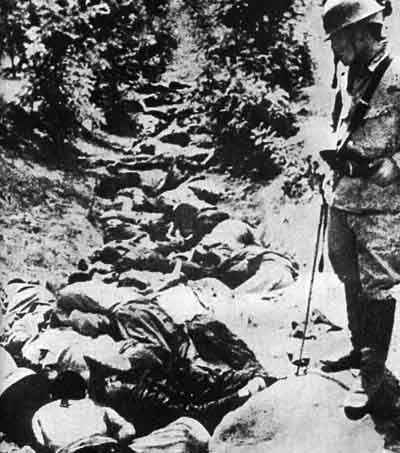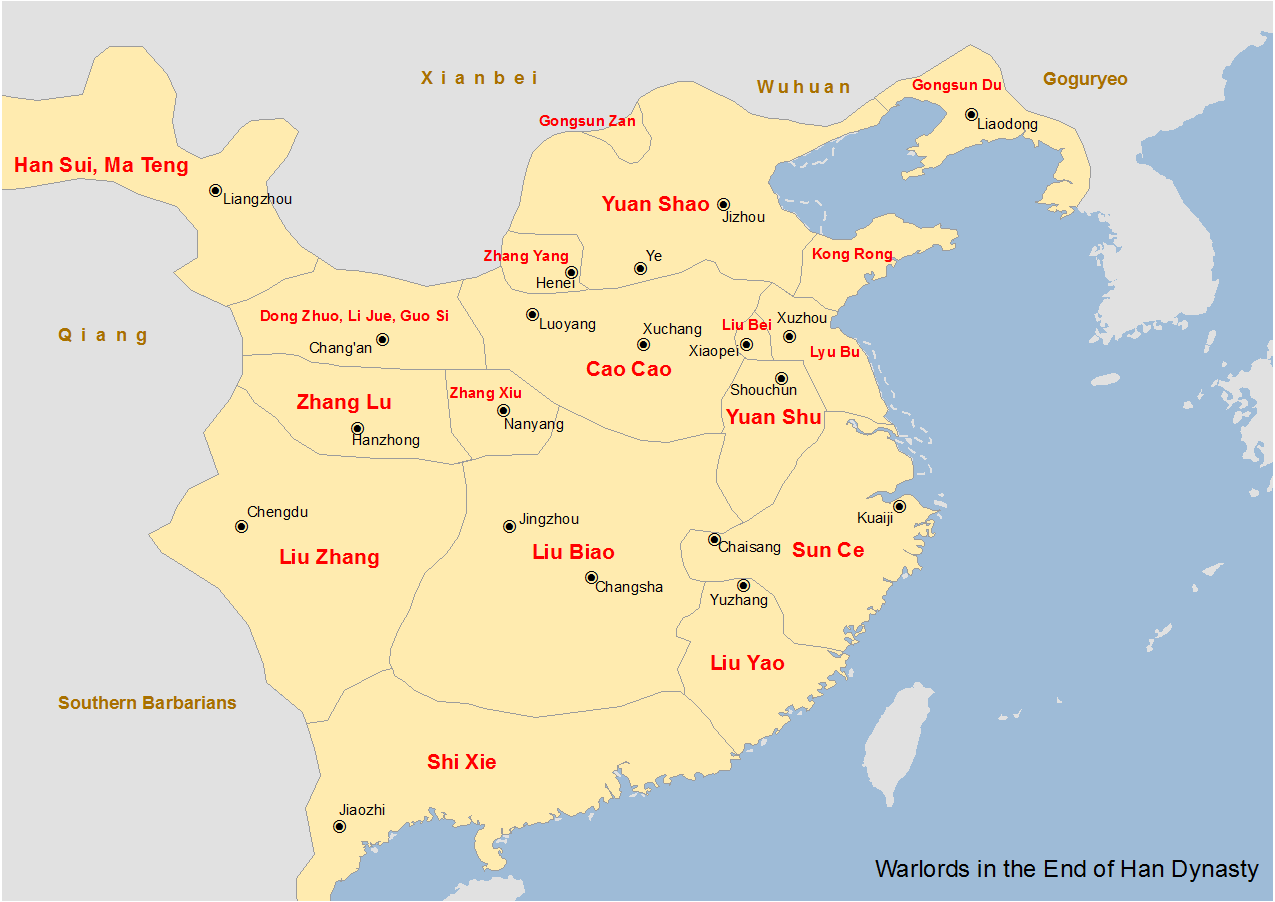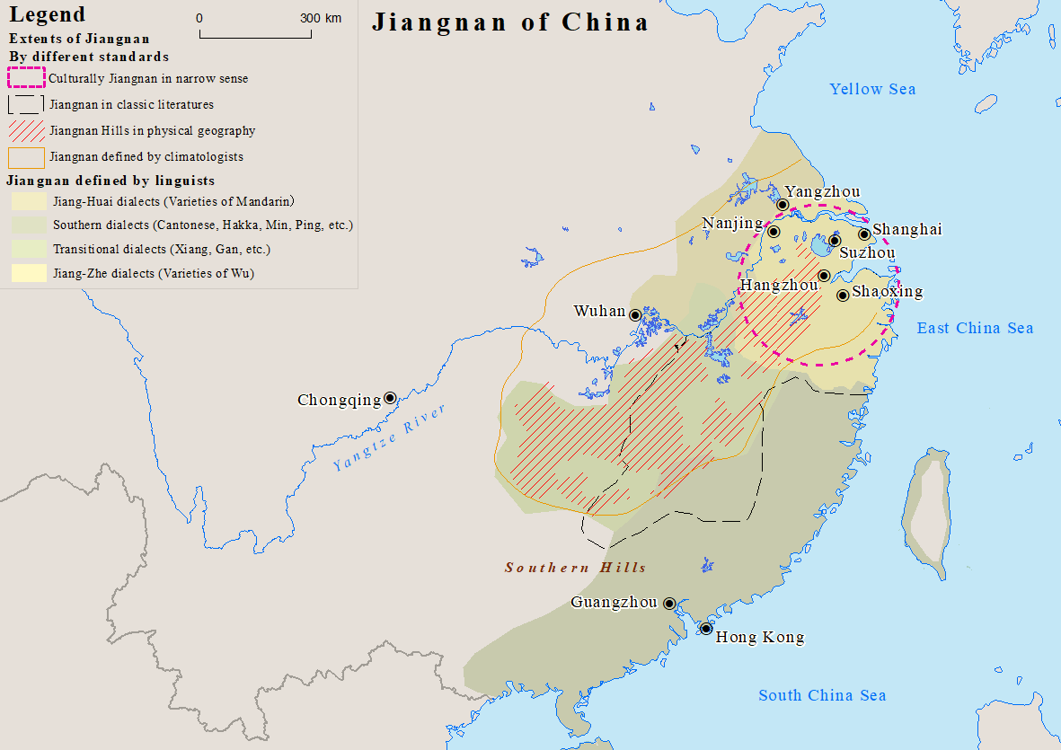|
Ze Rong
Ze Rong () (died 195 C.E.) was a minor warlord and Buddhist leader who lived during the late Eastern Han dynasty of China. He was active in Xu Province and was nominally a subordinate of the provincial governor, Tao Qian. When the warlord Cao Cao invaded Xu Province around 193, Ze Rong fled south with his followers, plundering two commanderies and killing their administrators along the way. He took shelter under the warlord Liu Yao but betrayed him later and seized control of Yuzhang Commandery (around present-day Nanchang, Jiangxi). Liu Yao ultimately defeated him and drove him out of the commandery. Ze Rong fled into the hills, where he was killed by the Shanyue tribes. Life Ze Rong was from Danyang Commandery (丹陽郡), which is around present-day Xuancheng, Anhui. He gathered a few hundred followers and brought them along to join Tao Qian, the Governor of Xu Province. Tao Qian appointed him as a logistics officer and tasked him with overseeing the transporting of resou ... [...More Info...] [...Related Items...] OR: [Wikipedia] [Google] [Baidu] |
Eastern Han Dynasty
The Han dynasty (, ; ) was an imperial dynasty of China (202 BC – 9 AD, 25–220 AD), established by Liu Bang (Emperor Gao) and ruled by the House of Liu. The dynasty was preceded by the short-lived Qin dynasty (221–207 BC) and a warring interregnum known as the ChuHan contention (206–202 BC), and it was succeeded by the Three Kingdoms period (220–280 AD). The dynasty was briefly interrupted by the Xin dynasty (9–23 AD) established by usurping regent Wang Mang, and is thus separated into two periods—the Western Han (202 BC – 9 AD) and the Eastern Han (25–220 AD). Spanning over four centuries, the Han dynasty is considered a golden age in Chinese history, and it has influenced the identity of the Chinese civilization ever since. Modern China's majority ethnic group refers to themselves as the "Han people", the Sinitic language is known as "Han language", and the written Chinese is referred to as "Han characters". The emperor was at the pinnacle of ... [...More Info...] [...Related Items...] OR: [Wikipedia] [Google] [Baidu] |
Xuzhou
Xuzhou (徐州), also known as Pengcheng (彭城) in ancient times, is a major city in northwestern Jiangsu province, China. The city, with a recorded population of 9,083,790 at the 2020 census (3,135,660 of which lived in the built-up area made of Quanshan, Gulou, Yunlong and Tongshan urban Districts and Jiawang District not being conurbated), is a national complex transport hub and an important gateway city in East China. Xuzhou is a central city of Huaihai Economic Zone and Xuzhou metropolitan area. Xuzhou is an important node city of the country's Belt and Road Initiative, and an international new energy base. Xuzhou has won titles such as the National City of Civility (全国文明城市) and the United Nations Habitat Scroll of Honour award. The city is designated as National Famous Historical and Cultural City since 1986 for its relics, especially the terracotta armies, the Mausoleums of the princes and the art of relief of Han dynasty. Xuzhou is a major city among t ... [...More Info...] [...Related Items...] OR: [Wikipedia] [Google] [Baidu] |
Zhuge Xuan
Zhuge Xuan () (died February 197) was a government official who lived during the late Eastern Han dynasty of China. He is best known for briefly serving as the Administrator of Yuzhang Commandery (around present-day Nanchang, Jiangxi) in the mid-190s. He was also a cousin-uncle ( first/second cousin once removed) of Zhuge Liang, a prominent statesman of the state of Shu Han during the Three Kingdoms period. Life Zhuge Xuan was from Yangdu County (), Langya Commandery (), which is located in present-day Yinan County or Yishui County, Shandong. His ancestor, Zhuge Feng (), was a Western Han dynasty official who served as Colonel-Director of Retainers () under Emperor Yuan (48–33 BCE). One of his cousins, Zhuge Gui (), served as an assistant official in Taishan Commandery (泰山郡; around present-day Tai'an, Shandong) during the late Eastern Han dynasty under Emperor Ling (168–189 CE). As Zhuge Gui and his wife died early, Zhuge Xuan raised their two younger sons, Zhu ... [...More Info...] [...Related Items...] OR: [Wikipedia] [Google] [Baidu] |
Jing Province
Jingzhou or Jing Province was one of the Nine Provinces of ancient China referenced in Chinese historical texts such as the ''Tribute of Yu'', '' Erya'' and '' Rites of Zhou''. Jingzhou became an administrative division during the reign of Emperor Wu (r. 141–87 BCE) in the Western Han dynasty (206 BCE–9 CE). It usually corresponded with the modern-day provinces of Hubei and Hunan until the Sui dynasty, after which it referred to the city of Jingzhou. History Pre-Qin era In the Warring States period, the Chu state covered most of present-day Hubei and Hunan, the areas that would form Jingzhou in a later era. The Qin state dropped the name "Chu" (楚) (literally "chaste tree") and used its synonym "Jing" (荊) instead to avoid a naming taboo, since the personal name of Qin's King Zhuangxiang (281–247 BCE) was "Zichu" (子楚; lit. "son of Chu") because his adoptive mother, Lady Huayang, was from Chu. Chu was conquered by Qin in 223 BCE in the final stages of the Q ... [...More Info...] [...Related Items...] OR: [Wikipedia] [Google] [Baidu] |
Liu Biao
Liu Biao () () (151 – September 208), courtesy name Jingsheng, was a Chinese military general, politician, and warlord who lived in the late Eastern Han dynasty of China. He is best known for serving as the Governor of Jing Province (covering present-day Hubei and Hunan) from 192 until his death in 208. He was also a member of the extended family of the Han emperors through his ancestor Liu Yu, the fifth son of Emperor Jing. Liu Biao was described as a handsome man and was over eight ''chi'' tall (1.86 metres). Life In 166 to 167, when Liu Biao was 17 (by East Asian reckoning), he became a student of Wang Chang (grandfather of Wang Can). At the time, Wang Chang was Administrator of Nanyang (南阳太守). When the Han dynasty was consumed with war following the Yellow Turban Rebellion in 184, Liu Biao held the governorship of Jing Province (covering present-day Hubei and Hunan). Liu Biao later started a war against the warlord Yuan Shu and his minor vassal, Sun Jian. D ... [...More Info...] [...Related Items...] OR: [Wikipedia] [Google] [Baidu] |
Jiangnan
Jiangnan or Jiang Nan (; formerly romanized Kiang-nan, literally "South of the River" meaning "South of the Yangtze") is a geographic area in China referring to lands immediately to the south of the lower reaches of the Yangtze River, including the southern part of its delta. The region encompasses the city of Shanghai, the southern part of Jiangsu Province, the southeastern part of Anhui Province, the northern part of Jiangxi Province and the northern part of Zhejiang Province. The most important cities in the area include Anqing, Changzhou, Hangzhou, Nanjing, Ningbo, Shaoxing, Suzhou, Wuxi, Wenzhou, and Zhenjiang. Jiangnan has long been regarded as one of the most prosperous regions in China due to its wealth in trade and very high human development. Most people of the region speak Wu Chinese dialects as their native languages. Etymology The word Jiangnan is based on the Chinese name for the Yangtze, ''Cháng Jiāng'', and ''nán'' meaning "south." In the 19th century, ... [...More Info...] [...Related Items...] OR: [Wikipedia] [Google] [Baidu] |
Sun Ce's Conquests In Jiangdong
Sun Ce's conquests in Jiangdong were a series of military campaigns by the warlord Sun Ce to conquer territories in the Jiangdong and Wu regions from 194 to 199 towards the end of the Eastern Han dynasty. The conquered lands served as a foundation for the state of Eastern Wu during the Three Kingdoms period (220–280). Background Sun Ce was the eldest son of the warlord Sun Jian, who was killed in action during the Battle of Xiangyang in 191 against Liu Biao, the Governor of Jing Province. Although Sun Ce was 16 when his father died, he was already well-known and was acquainted with many reputable men. In 194, Sun Ce went to meet the warlord Yuan Shu, to whom his father was previously subordinate. Yuan Shu was surprised to see Sun Ce, but he refused to return the command of Sun Jian's troops to Sun Ce. At the time, Sun Ce's maternal uncle Wu Jing, the Administrator of Danyang Commandery, was also a subordinate of Yuan Shu. Yuan Shu then ordered Sun Ce to travel to Danyang ... [...More Info...] [...Related Items...] OR: [Wikipedia] [Google] [Baidu] |
Sun Ce
Sun Ce () () (175–200), courtesy name Bofu, was a Chinese military general, politician, and warlord who lived during the late Eastern Han dynasty of China. He was the eldest child of Sun Jian, who was killed during the Battle of Xiangyang when Sun Ce was only 16. Sun Ce then broke away from his father's overlord, Yuan Shu, and headed to the Jiangnan, Jiangdong region in southern China to establish his own power base there. With the help of several people, such as Zhang Zhao (Eastern Wu), Zhang Zhao and Zhou Yu, Sun Ce managed to lay down the foundation of the state of Eastern Wu during the Three Kingdoms period. In 200, when the warlord Cao Cao was at war with his rival Yuan Shao in the Battle of Guandu, Sun Ce was rumoured to be planning an attack on Xuchang, Cao Cao's base. However, he was assassinated before he could carry out the plan. Sun Ce was posthumously honoured as "Prince Huan of Changsha" (長沙桓王) by his younger brother Sun Quan when the latter became the f ... [...More Info...] [...Related Items...] OR: [Wikipedia] [Google] [Baidu] |
Yang Province
Yangzhou, Yangchow or Yang Province was one of the Nine Provinces of ancient China mentioned in historical texts such as the ''Tribute of Yu'', ''Erya'' and ''Rites of Zhou''. Name There are four different theories regarding the origin of the name "Yangzhou": * Yangzhou's etymological root is related to trees. The ''Chunqiu Yuan Ming Bao'' recorded, "The soil is damp and moist, poplars and willows thrive there, that is how the name originated." Shen Kuo (1031–1095) wrote that "Yangzhou is suitable for poplars (楊; ''yang'') and Jingzhou is suitable for brambles (荊; ''jing'')." Li Dou (fl. 18th century) wrote that "Yangzhou is suitable for poplars (楊; ''yang'') and those growing on dykes are even larger. There is one (poplar tree) every five steps and two every ten steps, in pairs and threes they stand in gardens." Yangzhou is also sometimes written in Chinese as 楊州 instead of 揚州; 楊 means "poplar". * The origin of the name "Yangzhou" has something to do with wa ... [...More Info...] [...Related Items...] OR: [Wikipedia] [Google] [Baidu] |
Nanjing
Nanjing (; , Mandarin pronunciation: ), alternately romanized as Nanking, is the capital of Jiangsu province of the People's Republic of China. It is a sub-provincial city, a megacity, and the second largest city in the East China region. The city has 11 districts, an administrative area of , and a total recorded population of 9,314,685 . Situated in the Yangtze River Delta region, Nanjing has a prominent place in Chinese history and culture, having served as the capital of various Chinese dynasties, kingdoms and republican governments dating from the 3rd century to 1949, and has thus long been a major center of culture, education, research, politics, economy, transport networks and tourism, being the home to one of the world's largest inland ports. The city is also one of the fifteen sub-provincial cities in the People's Republic of China's administrative structure, enjoying jurisdictional and economic autonomy only slightly less than that of a province. Nanjing has be ... [...More Info...] [...Related Items...] OR: [Wikipedia] [Google] [Baidu] |
Jiangning District
Jiangning District () is one of 11 districts of Nanjing, the capital of Jiangsu province, China. The District has a population of 1,025,000 and an area of 1600 square kilometers. It includes southern and south-eastern suburbs of Nanjing. Jiangning Development Zone is located in this district. It has a population of 210,000. The Zone was approved on February 2, 1997, to be a national-level high and new technology industry development zone. In June 2001, the Zone won the ISO14001 environmental management system certificate. In June 2002, it won the title of the Jiangsu Provincial Base for Electronic and Information Industry. Approved Power automation industry base by National Science Ministry on October 30, 2004. Name The name of Jiangning is meaning "peace in Jiangnan", the character "jiang" () is meaning "river", especially meaning the Yangtze river; the character "ning" () is meaning "peace". Jiangning was established in 280, and it was named Linjiang () at that time. At the ne ... [...More Info...] [...Related Items...] OR: [Wikipedia] [Google] [Baidu] |
Li (unit)
''Li'' (, ''lǐ'', or , ''shìlǐ''), also known as the Chinese mile, is a traditional Chinese unit of distance. The li has varied considerably over time but was usually about one third of an English mile and now has a standardized length of a half-kilometer (). This is then divided into 1,500 chi or "Chinese feet". The character 里 combines the characters for "field" ( 田, ''tián'') and "earth" ( 土, ''tǔ''), since it was considered to be about the length of a single village. As late as the 1940s, a "li" did not represent a fixed measure but could be longer or shorter depending on the ''effort'' required to cover the distance. There is also another ''li'' (Traditional: 釐, Simplified: 厘, ''lí'') that indicates a unit of length of a ''chi'', but it is used much less commonly. This ''li'' is used in the People's Republic of China as the equivalent of the ''centi-'' prefix in metric units, thus ''limi'' ( 厘米, límǐ) for centimeter. The tonal difference makes i ... [...More Info...] [...Related Items...] OR: [Wikipedia] [Google] [Baidu] |






